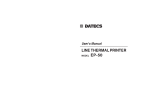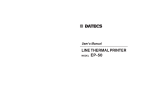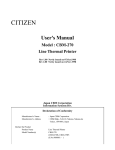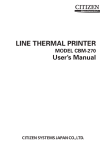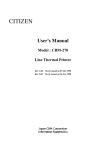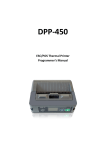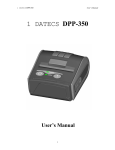Download Datecs LP-50 User`s manual
Transcript
User’s Manual LABEL THERMAL PRINTER MODEL LP-50 1 DATECS, Bulgaria THE INFORMATION IN THIS DOCUMENT CANNOT BE REPRODUCED IN ANY MECHANICAL, ELECTRICAL OR ELECTRONIC WAY AND UNDER ANY CIRCUMSTANCES WITHOUT THE WRITTEN CONSENT FROM DATECS LTD. Sofia 1784 - BULGARIA, tel: +359 2 974 00 55, fax: +359 2 974 11 00, e-mail: [email protected] VERSION 06.2008 / EN CONTENTS 1 OUTLINE .................................................................................... 1 3 1.1 Features ............................................................................13 1.2 Unpacking ...................................................................... 1 4 2 BASIC SPECIFICATIONS ......................................................... 1 5 2.1 Basic specifications ...................................................... 1 5 2.2 Paper Specifications ..................................................... 1 6 3 OUTER APPEARANCE AND COMPONENT PARTS ............. 1 8 4 OPERATION ............................................................................... 2 0 4.1 Connecting AC Adapter ................................................ 2 0 4.2 Connecting Interface Cable ......................................... 2 1 4.3 Inserting the Paper ....................................................... 2 1 4.4 Eliminating the Paper Jam ............................................ 2 3 4.5 LEDs ...................................................................................24 4.6 FEED Switch Function .................................................. 2 4 4.7 Paper End Function ....................................................... 2 4 4.8 How to Remove Remaining Paper Roll .................... 2 4 5 DIP SWITCH SETTING ............................................................ 2 5 5.1 Location of DIP Switch ................................................ 2 5 5.2 DIP Switch Function ...................................................... 2 5 1 DATECS LP-50 4 User’s Manual IMPORTANT SAFETY INSTRUCTIONS —Read all of these instructions and save them for future reference. —Follow all warnings and instructions marked on the product. —Unplug this product from the wall outlet before cleaning. Do not use liquid or aerosol cleaners. Use a damp cloth for cleaning. —Do not use this product near water. —Do not place this product on an unstable cart, stand or table. The product may fall, causing serious damage to the product. —Slots and openings on the back or cover these openings. The openings should never be blocked by placing the product on a bed, sofa, rug of other similar surface. This product should never be placed near or over a radiator or heater. This product should not be placed in an built-in installation unless proper ventilation is provided. —This product should be operated from the type of power source indicated on the marking label. If you are not sure of the type of power available, consult your dealer or local power company. —Do not allow anything to rest on the power cord. Do not place this product where the cord will be walked on. —If an extension cord is used with this product, make sure that the total of the ampere ratings of the products plugged into the extension cord does not exceed the extension cord ampere rating. Also, make sure that the total of all products plugged into the wall outlet does not exceed 15 amperes. —Never push objects of any kind into this product through cabinet slots as they may touch dangerous voltage points or short out parts that could result in a risk of fire or electric shock. Never spill liquid of any kind on the product. —Except as explained elsewhere in this manual, do not attempt to service this product by yourself. Opening and removing the covers that are marked “Do Not Remove” may expose you to dangerous voltage points or other risks. Refer all servicing on those compartments service to service personnel. —Unplug this product from the wall outlet and refer servicing to qualified service personnel under the following conditions: A. When the power cord or plug is damaged or frayed. B. If liquid has been spilled into the product. 5 1 DATECS LP-50 C. If the product has been exposed to rain or water. D. If the product does not operate normally when the operating instructions are followed. Adjust only those controls that are covered be the operating instructions since improper adjustment of other controls may result in damage and will often require extensive work by a qualified technician to restore the product to normal operation. E. If the product has been dropped or the cabinet has been damaged. F. If the product exhibits a distinct change in performance, indicating a need for service. —Please keep the poly bag which this equipment is packed in away from children or throw it away from children or throw it away to prevent children from putting it on. Putting it on may cause suffocation. CAUTIONS — Prior to using the equipment, be sure to read this User’s Manual thoroughly. Please keep it handy for reference whenever it may be needed. — The information contained herein may be changed without prior notice. — Reproduction of part or all of this User’s Manual without permission is strictly prohibited. — Never service, disassemble, or repair parts that are not mentioned in this User’s Manual. — Note that we will not be responsible for damages attributable to a user’s incorrect operation/handling or an improper operating environment . — Operate the equipment only as described in this User’s Manual; otherwise accidents or problems may result. — Data are basically temporaty; they cannot be stored or saved permanently or for a long time. Please note that we will not be responsible for damages or sses of profit resulting from losses of the data attributable to accidents, repairs, tests, and so on. — If you have any questions or notice any clerical errors or omissions regarding the information in this manual, please contact our office. — Please note that, notwithstanding them 8 above, we will not be responsible for any effects resulting from operation of the equipment. 6 User’s Manual SAFETY PRECAUTIONS – BE SURE TO OBSERVE In order to prevent hazards to an operator or other persons and damage to property, be sure to observe the following precautions. — The following describes the degrees of hazards and damages that can occur if the given instructions are neglected or the printer is incorrectly operated. ! WARNING Negligence of this precaution may result in death or serious injury. ! CAUTION Negligence of this precaution may result in injury or damage to property. ! i This is an illustration mark used to alert your attention. This is an illustration mark used to indicate such information as an instruction or the like. 7 1 DATECS LP-50 ! WARNING — Never handle the equipment in the following manners, as it may break, become out of order, or overheat causing smoke and resulting in fire or electric shock. If the equip ment is used in an abnormal condition, such as when broken, then problems, smoke emission, abnormal odor/noise, and fire can result. If an abnormal condition exists, be sure to disconnect the power plug from a plug socket, and contact our dealer. Never repair the equipment on your own – it is very dangerous. — Do not allow the equipment to receive a strong impact or shock, such as kicking, stamping, hitting, dropping, and the like. — Install the equipment in a well-ventilated place. Do not use it in such a manner that its ventilation port will be blocked. — Do not install the equipment in a place like a laboratory where chemical reactions are expected, or in a place where salt or gases are contained in the air. — Do not connect/disconnect a power cord or a data cable, while holding the cable. — Do not pull, install, use, or carry the equipment in such a manner that force will be applied to the cables. — Do not drop or insert any foreign substances, such as clips or pins, into the equipment. — Do not spill any liquid or spray any chemical-containing liquid over the equipment. If any liquid is spilled on it, turn off power, disconnect the power cable and power cord from the plug socket, and contract our dealer. — Never disassemble or remodel the equipment. Negligence of this may cause fire or electric shock. — Use the equipment only with the specified commercial power supply and AC adapter. Negligence of this may result in fire, electric shock, or problems. — If you drop or break the AC adapter, or if water or the like gets inside it, unplug it immediately from the socket and contact your dealer. — Do not damage, break, process, bend/pull by force, twist, or head an AC adapter cord. Also, do not put a heavy substance on it or heat it. The AC adapter cord could be broken, resulting in fire, electric shock, or trouble. If the AC adapter cord is damaged, contact our dealer. — Do not connect/disconnect the AC adapter with wet hands. — Do not overload a single electrical outlet, using a table tap or a current tap socket. — An equipment packing bag must be discarded or kept away from children. A child can suffocate if the bag is placed over the head. 8 User’s Manual ! PRECAUTIONS FOR INSTALLATION — Do not use or store the equipment in a place exposed to fire, moisture, or direct sunshine, or in a place near a heater or thermal device where the prescribed operating temperature and humidity are not met, or in a place exposed to much oil, iron powder, or dust. The equipment may become out of order, emit smoke, or catch fire. — Do not install or use the equipment in a place like a laboratory where chemical reactions are expected, or in a place where salt or gases are contained in the air. There is a danger of fire or electric shock. — Install the printer on a flat, stable desk or table that is free from vibration, in a well-ventilated place. — Do not install the printer at a location where its operation could be hindered. — Do not place anything on the printer or leave small objects, like a clip or pin, around it. A foreign object could cause trouble if it gets inside. — Do not use any sharp-pointed object, such as a pen, for example, to touch the operation panel of the printer. It could cause trouble. — Do not use the equipment near a radio or TV receiver. Do not share the power from a plug socket a radio or TV receiver is connected to. It may cause a reception problem. — Use the equipment only at the specified power supply, voltage and frequency. Otherwise, it may emit smoke and catch fire or cause other problems. — Connect only the specified power source. Use of an unspecified power source could cause trouble or smoke/fire. — Confirm that a plug socket used for connection has sufficient capacity. — Avoid connecting a power cable to a plug socket shared by other devices or extending the wiring too far. It may result in the cable catching fire or a power outage. Also, do not step on or apply an excessive force (Pull, Load) to the cable, and do not use the printer with such a force applied to it. — Never connect a grounding cable (Frame ground) to a gas pipe. There is a danger of explosion. When connecting or disconnecting the grounding cable,be sure to disconnect the power cable and the power plug from the plug socket. — When connecting/disconnecting the cables, be sure to turn off the power first, including the connected side, and then connect/disconnect them, holding a plug and a connector. Pulling the cable itself could cause it to snap or become damaged. — Connect a power cable or a connector cable securely. If a reverse-polarity connection is a made, internal elements may be broken or a mating device may be ad versely affected. 9 1 DATECS LP-50 — Use a shielding wire or twisted pair wire for a signal line, in order to minimize noise effect. Do not route the cable too long or connect it to a noisy device. Connection to a noisy device could cause erroneous printing due to corrupt data, and so on. — Use the equipment in an environment where there is s plug socket near the main body and you can easily disconnect the power plug from it, to shut off the power. — When the equipment will not be used for a long period of time, unplug it and remove the paper roll from it. — When transporting the equipment, remove the paper roll from paper holder. 10 User’s Manual ! PRECAUTIONS FOR HANDLING Do not handle the equipment in the following manners, because problems may result. — Do not use any other power source besides the accessory AC adapter. Also, do not use the AC adapter for other purposes. — Do not print without paper. — Do not drop or put any foreign object, such as a clip, pin, or the like, inside the printer. — Do not spill any liquid or spray any chemical-containing liquid over the equipment. — Never use a pointed object, such as a pen, to operate the operation panel. — Do not use Scotch tape to fasten paper together for continuous use. It could damage the printing head. — Never pull the set paper forcibly. When opening/closing the printer cover, take care that the paper will not be caught. It could cause the paper to jam. — Be sure to use the specified paper. Use of other paper could deteriorate the print quality or cause a problem with the printing head. To Prevent and Spreading of Damage — Never touch the printing head motor, or paper cutting blade. Your finger may be cut. — During power-on or immediately after printing, do not touch electrical parts or moving parts, such as the mechanism, motor, internal dear, etc. They may be very hot and can burn your hand/finger. — Be careful to avoid bodily injure or damaging other objects with an edge of sheet metal. — Should any error occur while operating the equipment, stop it immediately and disconnect the power plug from the plug socket. — Only a qualified serviceman is allowed to disassemble or repair the printer. — Should a problem occur, leave solving it to our serviceman. Do not disassemble the equipment on your own. — When opening/closing the printer cover, and so on, be careful not to catch your hand or finger on the equipment. — After using the equipment, turn off the power switch and unplug the AC adapter from a plug socket. 11 1 DATECS LP-50 i DAILY MAINTENANCE — At the time of maintenance, be sure to turn off the power switch of the printer and unplug it from the socket. — Use a dry soft cloth to wipe off stains and dust from the surfaces of the main body case. For severe soiling, dip the cloth in water and wring it, for wiping offthe soil. Never use organic solvents, such as alcohol, thinner, trichlene, benzene, ketone, or chemical dusters. — If the equipment is contaminated with paper powder, use a soft brush to clean it. Be careful not to damage the printing head. — Cleaning the Printing Head 1. Referring to “4.5 Removing Paper Jam”, detach the platen roller unit. 2. Moisten gauze slightly with alcohol, and clean the heating surface of the printing head with it. 3. Reattach the platen roller unit. ! CAUTION The printing head and motor are very hot. Be careful not to touch them immediately after printing. Do not touch the heating surface of the head with a bare hand or metal. When detaching or reattaching the platen roller unit, be sure to raise up the printing head, otherwise, they could be damaged. Handle the detached platen roller unit carefully so as not to damage it. 12 User’s Manual 1. OUTLINE This LP-50 is a compact-sized, label thermal printer is designed for various types of data communication terminals and measuring instrument terminals. Its abundant built-in features allow you to widely use this printer for different applications. Prior to using it, read and understand this manual thoroughly. 1.1 Features It can be used in variety of applications because: - Small, lightweight and installable in a narrow area - High speed and low noise, owing to line thermal print - Long-life printing head and high reliability, owing to the simple mechanism - Easy paper/label-loading, owing to the auto-loading function - Built-in input buffer - Capable of printing a bar code - There is an independent power supply (AC adapter) 13 1 DATECS LP-50 1.2 Unpacking When unpacking the package, confirm that the following parts are provided: —Printer body ................................ 1 unit —Sample paper/label roll ............. 1 roll —AC adapter .................................. 1 piece —User’s manual ........................... 1 copy —CD-R ........................................... 1 piece ! CAUTION — Install the printer body on a flat and stable desk or mount it onto the wall, etc., using a hook, etc. — Do not install the printer near a heater or in a place exposed to the direct sunshine. — Do not use the printer in a high-temperature, high-humidity, or contaminated environment. — Do not allow dew condensation to form on the printer. If such condensation should form, do not turn on the power until it has completely gone away. — Use only the accessory AC adapter. Do not use it for any other purpose. — If you do not use the printer for a long period, disconnect the power cable from the socket. — Keep this manual carefully at hand for ready reference. 14 User’s Manual 2. BASIC SPECIFICATIONS 2.1 Basic specifications Printing system Printing width Dot density Paper feed pitch Printing speed Character size Character types Barcode type Paper Interface Input buffer Download characters AC adapter Power consumption Weight Outer dimensions Operating temperature and humidity Storage temperature and humidity Reliability Line thermal dot printing 48 mm (384 dots/line) 8 dots/mm (Width, Length) 0.125 mm up to 50 mm/s 12´24, 9´16, 24´24 (only for asian versions) Alphanumerals, symbols, international characters (Choose from 20 countries) UPC-A/E, JAN(EAN) 13-/8-column, ITF, CODE 39, CODE 93, CODE 128, CODABAR, PDF417 Thermal paper roll: 58 + 0/- 1 mm ´ f 83 (max) mm, 60~75 mm thick Thermal label paper: 58 + 0/- 1 mm ´ f 83 (max), 150 mm thick (max) (L and M Spec. only) Label width: 56 mm (max) Label length: 25 mm/sh. (min) Serial (RS-232C) 16 KB To downloaded fonts: 12´24, 9´16 Rated input : 100~240 V, 50/60 Hz, 40 VA Rated output : 12 V DC, 2,5 A At non-printing: Approx. 2 W At printing: Approx. 15 W (approx. 20 W at maximum) Main body: Approx. 600 g (Paper roll excluded) AC adapter: Approx. 350 g 106 (W) ´ 184 (D) ´ 110 (H) mm 5~400C, 35~85 % RH (No dew condensation) -20~600C, 10~90% RH (No dew condensation) Printing head life: (250C) Pulse resistance: 50 million pulses or more (Print rate 12.5%) Wear resistance: 50 km or more (With recommended thermal paper at normal temperature and humidity) 15 1 DATECS LP-50 2.2 Paper Specifications 2.2.1 Recommended Paper Thermal paper roll Type: Thermal paper Paper width: 58 + 0/–1 mm Paper thickness: 60~75µm Roll diameter: φ 83 mm or less Printing surface: Outside of the roll (Surface) Recommended paper: TF50KS-E2C (Monochrome) made by NIPPON SEISHI or its equivalent 735FA (2-color, Black based) made by RICOH or its equivalen PB670 (2-color, Red based) made by MITSUBISHI SEISHI or its equivalent Core: φ12 mm (Inner dia.), φ18 mm (Outer dia.) ! CAUTION — Use of non-specified paper may cause irregularity of print density. — Do not paste the paper to the core. — If the paper comes in contact with a chemical or oil, it may discolor or lose a record. — Do not rub the paper surface strongly with a nail or hard metal. It may discolor. — Discoloring starts at about 700C. Watch out for effects of heat, humidity, light, and so on. — Do not use the label paper when the printer has been set for thermal paper, and vice versa. Be careful not to mistake a type of label paper. It could cause malfunctioning or damage the printing head. 16 User’s Manual 2.2.2 Recommended Paper Thermal paper 2.2.3 Printing Head and Paper Cutter Layout 17 1 DATECS LP-50 3. OUTER APPEARANCE AND COMPONENT PARTS (13) RS232 Interface (12)Power Conector Drawer Control AC adapter 18 User’s Manual (1) POWER switch Turns on/off the power for the printer body. (2) POWER lamp Lights green when the printer is switched on (3) ERROR lamp Flashes red when the printing head is overheated. (4) PAPER lamp Flashes red when the printer is out of paper, lights red constantly if the paper is put, but the lever is not pushed down. (5) FEED switch (Button LF) Feeds the paper. It is fed continuously while the switch is held down. (6) Paper holder Set the paper roll in this holder. (7) PNE sensor Detects that the paper is running out. (8) DIP switch Initially sets the printer at power-on and sets the functions. (9) Platen roller unit Detach this unit when the paper is jamming or when you clean the head. (10) Head-up lever Used when replacing the paper or detaching/reattaching the platen roller unit. (11) Paper cutter Cuts the printed paper. (12) Power connector Connects to the accessory AC adapter. (13) Interface connector Connects to a communication interface cable. (14) Printer cover Detach this cover when replacing the paper. 19 1 DATECS LP-50 4. OPERATION 4.1 Connecting AC Adapter 1 Turn off the power. 2 Connect the cable connector of the AC adapter to the power connector located on the back of the printer. 3 Connect the AC power cord of the AC adapter, and plug it into a socket. ! CAUTION — Use only the specified AC adapter. — When disconnecting/reconnecting the cable connector of the AC adapter, be sure to hold the connector. — Separate the AC adapter from other noise-generating devices. — Pulling the AC power cord may damage it, resulting in a fire, electric shock, or snapping. — If a thunder/lightning storm is nearby, disconnect the AC adapter from the socket and do not use the printer, because a fire or electric shock may occur. — Do not put the AC power cord close to a heating device. Its coating can mel and cause a fire or electric shock. — Install the printer in a well-ventilated place, because the AC adapter generates heat when it is used. — Use the specified AC power source. Connect to a power source with sufficient capacity. If the capacity is insufficient, a fire may result from heat generation. — After using the printer or when not using it for a long period of time, be sure to unplug the AC adapter from a plug socket for your safety. 20 User’s Manual 4.2 Connecting Interface Cable 1 Turn off the power. (Mating side included) 2 Check the top and bottom of cable terminals, and connect to the interface connector. 3 Connect the cable to the host computer. 4.3 Inserting the Paper ! CAUTION — Be sure to use the specified paper roll. — Use of non-specified peper may not guarantee the print quality, printing head life, and so on. 1 2 3 4 Hold the convexity on the rear of the printer cover, and raise it upward. Cut the front end of the paper roll almost at a right angle. Make sure that the power is turned on. Pull the head-up level to this side to raise up the printing head. 5 If there is still some paper remaining after a paper-out indication, eliminate the paper roll according to “4.8 How to Remove Remaining Paper Roll.” 6 Insert the front end of the paper roll straight into a paper insertion slot. 7 Set the paper roll firmly in the paper holder. 8 Put back the head-up lever. The paper roll is automatically puiied in by the platen roller to feed a constant amount of paper. (When auto-loading is enabled.) 9 Put back the printer cover. 21 1 DATECS LP-50 ! CAUTION — The printer cover is not stationary (Opening/Closing). After detaching it, be careful not to lose or break it — Do not insert a ragged or dog-eared end of the paper roll, because it could result in a paper jam or insertion error. ! CAUTION — If the paper roll is still slack, rewind the paper to remove the slack — If the paper roll is tilted, rais the head-up lever to correct the paper roll posotion, or pull out the paper roll and set it again. — Do not open the printer cover while printing. — Do not hold or press the paper roll while printing, because it could cause a paper jam. — After the paper is set, the printer is made ready to start printing. Note that if data is remaining in the buffer, the printer will start printing after the paper is set. — Do not run the printer with its cover removed, because it could cause malfunctioning or an irregularity of the sensor. 22 User’s Manual 4.4 Eliminating the Paper Jam 1 2 3 4 5 Turn off the power. Detach the printer cover. Cut the paper roll near the paper insertion slot. Raise the head-up lever. Raise the blue levers located on both sides of the platen roller unit, to gently detach the unit. The platen roller unit can be detached by manually raising the blue levers. 6 Remove the remaining paper roll completely from the paper passage. 7 Confirming the direction of the platen roller unit, reattach it to the mechanism. Shift down the blue levers on both sides, to fix the unit. 8 Lower the head-up lever. ! CAUTION - Do not carry out this work just after printing because the printing head is very hot. - Be sure to turn off the power when detaching the platen roller unit. - When eliminating remaining paper, do not touch the heating surface of the head with a bare hand or metal piece. - Do not detach the platen roller unit unless necessary, such as for a paper jam. - When putting back the platen roller unit, be sure to confirm that it is correctly reattached. - Never detach or reattach the platen roller unit with the head-up lever lowered. 23 1 DATECS LP-50 4.5 LEDs POWER Lights green when the printer is switched on. ERROR Flashes red when the printing head is overheated. PAPER Flashes red when the printer is out of paper, lights red constantly if the paper is put, but the lever is not pushed down. 4.6 FEED Switch Function P Pressing this button feeds the paper until it is released. P The button must be pressed to continue printing after out of paper error. P If a manual macro execution is selected the button must be pressed for each macro execution. P Holding down the button while the printer is switched on prints the self test when the button is released. 4.7 Paper End Function After replacing the paper the printer will resume printing after the Line Feed buttons pressed once. Replace the paper according to “4.3 Inserting the Paper.” 4.8 How to Remove Remaining Paper Roll 1 Remove the printer cover. 2 Raiser the head-up lever. 3 Gently pull out the paper to the near side. If the paper roll is still remaining, cut it just before the paper insertion slot before pulling it out. ! CAUTION —Do not pull out the paper roll in the opposite direction. —Never take out paper with the head-up lever lowered, because it could damage the printing head. —The printer mechanism may be very hot just after printing, so be duly careful. 24 User’s Manual 5. DIP SWITCH SETTING 5.1 Location of DIP Switch 1 Turn off the power. 2 Detach the printer cover, and take out the paper roll. (The switch is ound under the paper roll.) 3 There is 1 DIP switch (8-pole ) for the serial interface. 5.2 DIP Switch Function Sw1 Sw2 Sw3 Baud rate (bps) OFF OFF OFF Local keyboard ON OFF OFF 2400 OFF ON OFF 4800 ON ON OFF 9600 OFF OFF ON 19200 ON OFF ON 38400 OFF ON ON 57600 ON ON ON 115200 OFF ON Sw4 Hardware protocol XON / XOFF protocol Sw6 Paper roll printing Sticker label Sw8 Normal operation mode LP-50 compatible 25

























